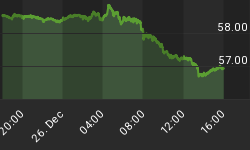April Fools! That is what it feels like when investing in this market. If you put money to work now and the market tanks, you feel like a fool. If you sit on your hands and watch the market levitate higher week after week, you feel like a fool. If you do jump in and the market goes higher, it is likely that you will need to be very nimble to lock in those gains as the best, most accelerated gains are behind us. What is an investor to do? You cannot win. In the end, the markets are a zero sum game, and we are all fools anyway! Ughhhh!
The "Dumb Money" indicator (see figure 1) looks for extremes in the data from 4 different groups of investors who historically have been wrong on the market: 1) Investors Intelligence; 2) MarketVane; 3) American Association of Individual Investors; and 4) the put call ratio. This indicator shows extreme bullishness. As stated last week: "If we look at the "dumb money" indicator in figure 1, we know that as long as the indicator stays above the upper band (see green arrow on chart), prices should continue to go higher - albeit in a grinding fashion at this stage of the rally. This is the syndrome I call "it takes bulls to make a bull market". If the indicator closes below the upper band, then the best time to sell is usually one week after this occurrence. In this instance, the market is rolling over and those late to the party are buying that dip. The data shows that this is the optimal time to sell. But these are optimal scenarios, and I should caution that optimal and stock market are rarely spoken of in the same sentence. The market is just too unpredictable. Who saw the May, 2010 "flash crash" or the 20% drop over 3 weeks in 2011 coming? If you hang around too long, you could be one of those casualties. Alas, there are no right answers or guarantees. These are just signposts that help us better understand the price action."
Figure 1. "Dumb Money"/ weekly
Figure 2 is a weekly chart of the SP500 with the InsiderScore "entire market" value in the lower panel. From the InsiderScore weekly report: "A sell bias persisted across the market last week as insider trading volume began to seasonally decline. Companies have started closing trading windows, limiting insiders' ability to trade. Volume will continue to decrease over the next three-to-four weeks as companies prepare Q1'12 earnings announcement."
Figure 2. InsiderScore "Entire Market" value/ weekly
Figure 3 is a weekly chart of the SP500. The indicator in the lower panel measures all the assets in the Rydex bullish oriented equity funds divided by the sum of assets in the bullish oriented equity funds plus the assets in the bearish oriented equity funds. When the indicator is green, the value is low and there is fear in the market; this is where market bottoms are forged. When the indicator is red, there is complacency in the market. There are too many bulls and this is when market advances stall. Currently, the value of the indicator is 67.13%. This is the second week in a row that the indicator has turned down week over week. Values less than 50% are associated with market bottoms. Values greater than 58% are associated with market tops. It should be noted that the market topped out in 2011 with this indicator between 70% and 71%.
Figure 3. Rydex Total Bull v. Total Bear/ weekly
TheTechnicalTake offers a FREE e-newsletter: HERE
















